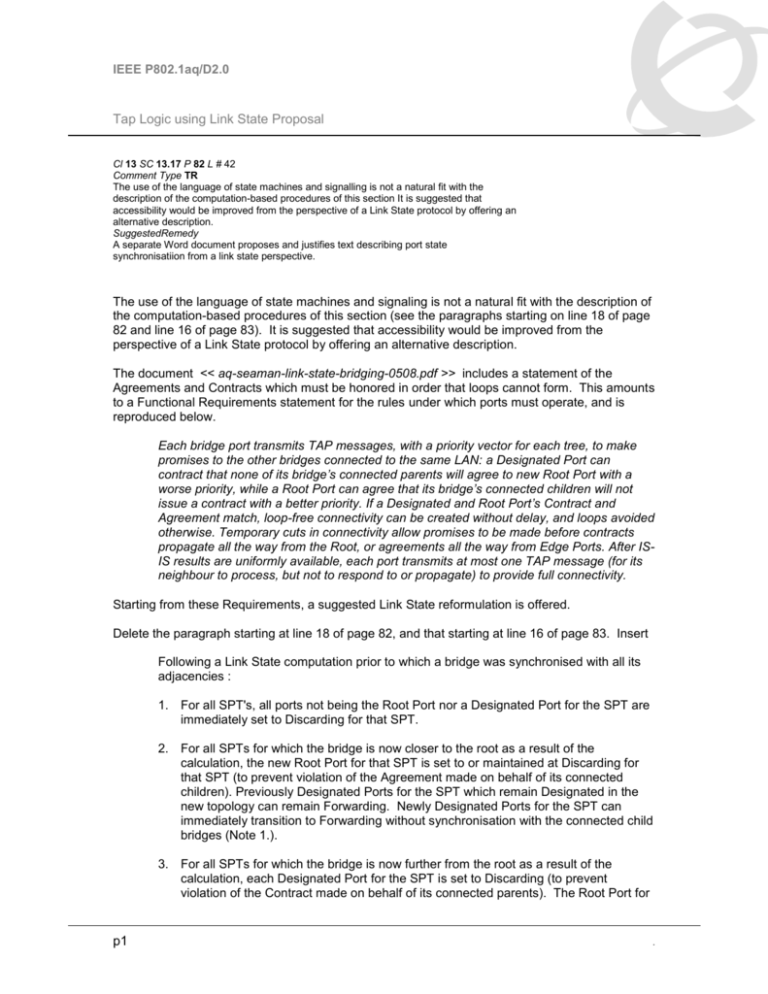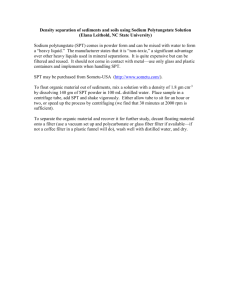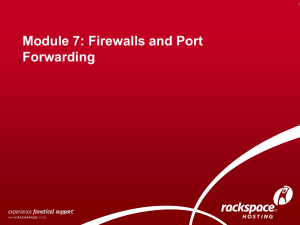aq-parsons-TapLogic
advertisement

IEEE P802.1aq/D2.0 Tap Logic using Link State Proposal Cl 13 SC 13.17 P 82 L # 42 Comment Type TR The use of the language of state machines and signalling is not a natural fit with the description of the computation-based procedures of this section It is suggested that accessibility would be improved from the perspective of a Link State protocol by offering an alternative description. SuggestedRemedy A separate Word document proposes and justifies text describing port state synchronisatiion from a link state perspective. The use of the language of state machines and signaling is not a natural fit with the description of the computation-based procedures of this section (see the paragraphs starting on line 18 of page 82 and line 16 of page 83). It is suggested that accessibility would be improved from the perspective of a Link State protocol by offering an alternative description. The document << aq-seaman-link-state-bridging-0508.pdf >> includes a statement of the Agreements and Contracts which must be honored in order that loops cannot form. This amounts to a Functional Requirements statement for the rules under which ports must operate, and is reproduced below. Each bridge port transmits TAP messages, with a priority vector for each tree, to make promises to the other bridges connected to the same LAN: a Designated Port can contract that none of its bridge’s connected parents will agree to new Root Port with a worse priority, while a Root Port can agree that its bridge’s connected children will not issue a contract with a better priority. If a Designated and Root Port’s Contract and Agreement match, loop-free connectivity can be created without delay, and loops avoided otherwise. Temporary cuts in connectivity allow promises to be made before contracts propagate all the way from the Root, or agreements all the way from Edge Ports. After ISIS results are uniformly available, each port transmits at most one TAP message (for its neighbour to process, but not to respond to or propagate) to provide full connectivity. Starting from these Requirements, a suggested Link State reformulation is offered. Delete the paragraph starting at line 18 of page 82, and that starting at line 16 of page 83. Insert Following a Link State computation prior to which a bridge was synchronised with all its adjacencies : 1. For all SPT's, all ports not being the Root Port nor a Designated Port for the SPT are immediately set to Discarding for that SPT. 2. For all SPTs for which the bridge is now closer to the root as a result of the calculation, the new Root Port for that SPT is set to or maintained at Discarding for that SPT (to prevent violation of the Agreement made on behalf of its connected children). Previously Designated Ports for the SPT which remain Designated in the new topology can remain Forwarding. Newly Designated Ports for the SPT can immediately transition to Forwarding without synchronisation with the connected child bridges (Note 1.). 3. For all SPTs for which the bridge is now further from the root as a result of the calculation, each Designated Port for the SPT is set to Discarding (to prevent violation of the Contract made on behalf of its connected parents). The Root Port for p1 . IEEE P802.1aq/D2.0 Tap Logic using Link State Proposal the SPT in the new topology can remain or be set to Forwarding without synchronization Bridges may implement an alternative interoperable process at 3 : For all SPTs for which the bridge is now further from the root as a result of the calculation, the Root Port for the SPT in the new topology is set to Discarding. 4. For all SPTs for which the bridge remains the same distance from the root as a result of calculation, the Root Port for that SPT is set to or maintained at Forwarding for that SPT. Previously Designated Ports for the SPT which remain Designated in the new topology can remain Forwarding. Newly Designated Ports for the SPT can immediately transition to Forwarding without synchronisation with the connected child bridge (Note 1.). Having executed steps 1. to 4. (and thereby setting to Discarding all ports for all SPTs which could cause looping in the absence of synchronisation), the bridge computes and sends an Agreement Digest to all its IS-IS adjacencies. 5. When a matching Agreement Digest is received on a port, all SPTs for which that port is the Root Port or a Designated Port may be set to Forwarding on that port. If the Root Port for the SPT in the new topology was set to Discarding by step 3. above, a matching Agreement Digest must be received on all Designated Ports before the Root Port can be set to Forwarding. Note 1. The purpose of this statement is to allow forwarding to continue uninterrupted if the topology change has not affected an SPT, and also to allow fast root port failover where permissible. It is safe because the child bridge will only set its connected port to Root Port and Forwarding without synchronisation under conditions 3. or 4. above, so that the child bridge must be the same distance or further from the root in the new child topology view. The parent bridge's newly Designated Port can only become Forwarding if the parent bridge is the same distance from or closer to the root in the new parent topology. So, the connected ports on both bridges will only both be Forwarding if both bridges place the parent closer to the root than the child in their respective local views of the topology, which ensures no loop can form. p2 .








